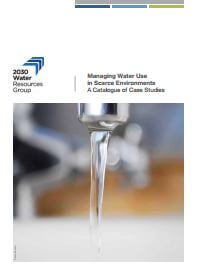Call for innovative water scarcity solutions
If you know any initiatives that focus on reducing water use or managing water risk globally, help us share your best practices with the larger water community.
How to submit your case study?
Please contact water.scarcity.solutions@arup.com with the following information:
- Where was your initiative located?
- What were the objectives and outcomes of the intervention?
- When was the intervention undertaken?
- What data is available?
- Your name and contact information
The Global Rationale
Water scarcity is also viewed as a top threat to society by heads of states, business and non-profits, as reported in the 10th Global Risk Report by the World Economic Forum (WEF), and there is predicted to be a 40% gap by 2030 in demand and availability of freshwater according to 2030 WRG. Recent droughts in California and Sao Paolo highlight some of the increasing challenges faced by decision makers around the world from both the (developed and developing) in balancing the need for municipal water supply for citizens, the needs of agriculture and industry, and the maintenance of environmental flows to protect the river basin ecosystems.
The 2030 Water Resources Group is taking a leading role in identifying and publishing examples of initiatives that have been implemented to manage water scarcity. In 2013, on behalf of the 2030 Water Resources Group, Arup identified 40 case studies from around the world that showcased such innovative solutions in ‘Managing Water Use in Scarce Environments: A Catalogue of Case Studies’. The publication inspires action and is utilized throughout the world by leading industry, policy makers and the 2030 WRG country programs.
Revised and updated
Based on the positive feedback WRG received from various stakeholders on the first edition of the Catalogue of Case Studies, 2030 WRG initiated a second phase of the project which will identify a further 40 case studies. The online catalogue with a number of new case studies has recently been launched at the 25th Stockholm World Water Week in Sweden. The revised publication ‘Managing Water Use in Scarce Environments: A Catalogue of Case Studies’, will analyze projects where actions were taken to address the water scarcity. These new case studies will utilize the simple but robust framework and assessment methodology used to evaluate projects presented in the pilot catalogue published in 2013.
The extended catalogue will be a key instrument that serves as:
- A source of current available solutions for water use transformation;
- An open platform for information between governments, solutions and solution providers and other stakeholders;
- A tool to test the current framework for the evaluation of case studies, both with respect to cost per cubic meter of freshwater saved/made available and the benefit of contributing to close the water gap.
The latest catalogue contains a wider array of case studies. These include small-scale agricultural interventions and micro-irrigation technologies in Peru, a wastewater reuse project at an industrial complex in India, and a global corporate water efficiency program by Anglo American mining group. It also showcases innovative ideas such as the use of remote sensing and satellite imagery to optimize water use in farming and the utilization of new online platforms to influence behavior change in consumers.
The range of projects highlight that improved management of water can be achieved in a wide range of circumstances provided the right combination of drivers are present. The case studies also highlight the need for improved collaboration between the public and private sectors; standardized data collection, monitoring and reporting; and a means of ensuring action is relevant at river basin scale.
See the online catalogue www.waterscarcitysolutions.org

